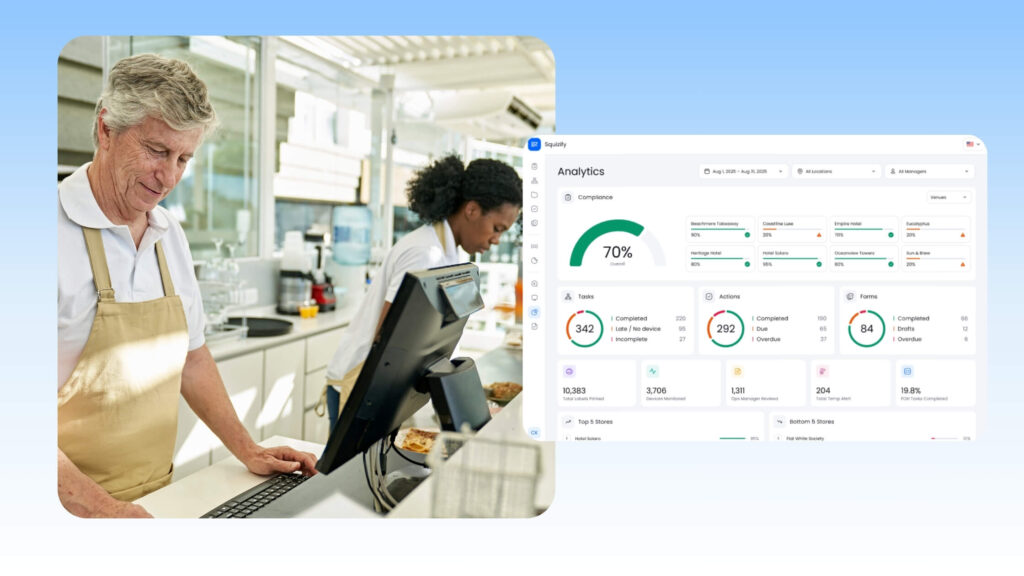Can a Restaurant Be Shut Down for Not Having a Digital Food Safety System?

Restaurant owners often ask whether lacking a digital food safety system can lead to their establishment being shut down. The answer isn’t straightforward – food safety compliance involves multiple factors beyond digital systems.
Food safety remains critical in protecting public health and maintaining restaurant reputation. A single foodborne illness outbreak can devastate a business, resulting in closure, legal issues, and damaged customer trust.
Digital food safety systems have changed how restaurants manage compliance:
- Real-time food safety temperature monitoring
- Automated record-keeping
- Instant access to safety documentation
- Streamlined inspection processes
Many restaurant operators worry about health inspections and potential closures. While digital systems aren’t legally mandatory, traditional paper-based methods can create compliance challenges:
- Missing or incomplete records
- Human error in documentation
- Difficulty tracking corrective actions
- Limited visibility into safety trends
Understanding the relationship between digital systems and compliance helps restaurant owners make informed decisions about their food safety management approach.

1. What is the Role of a Digital Food Safety System in Restaurant Compliance?
Restaurants cannot be shut down solely for lacking a digital food safety system. Health inspectors focus on actual food safety violations rather than the specific methods used to track compliance.
Local and state health departments establish specific requirements for:
- Temperature monitoring
- Cleaning schedules
- Food storage practices
- Employee hygiene protocols
Restaurant closures stem from critical violations that pose immediate health risks:
- Severe pest infestations
- Cross-contamination of raw and ready-to-eat foods
- Improper food temperature control
- Lack of hot water for handwashing
While digital systems help maintain compliance through automated tracking and alerts, traditional paper-based methods remain acceptable if properly maintained. The key lies in consistent documentation and adherence to food safety protocols, regardless of the tracking method used.
Health inspectors evaluate the effectiveness of a restaurant’s food safety practices through direct observation and record review. They assess whether the chosen system – digital or manual – successfully prevents foodborne illness risks.
2. Key Food Safety Requirements Restaurants Must Follow:
Restaurants must adhere to strict food safety regulations to protect public health. Here are the essential requirements:
Temperature Control
- Hot foods are maintained above 63°C
- Cold foods stored below 5°C
- Regular temperature checks and documentation
- Proper cooling and reheating procedures
Hygiene Standards
- Hand washing stations with soap and paper towels
- Clean uniforms and protective gear
- Regular cleaning schedules for equipment
- Proper sanitisation of food contact surfaces
Documentation Requirements
- Daily temperature logs
- Cleaning schedules
- Staff training records
- Supplier certificates
- HACCP documentation
Certified Personnel
- Food Safety Supervisor on premises
- Staff trained in food handling
- Regular competency assessments
- Up-to-date certifications
These requirements need systematic monitoring and documentation. Health inspectors check these records during routine inspections to ensure compliance with local health codes.
3. What are the Benefits of Implementing a Digital Food Safety System in Your Restaurant?
Digital food safety software transforms daily operations with powerful automation and real-time monitoring capabilities. These systems deliver immediate benefits:
1. Instant Data Access
- View temperature logs from anywhere
- Track food safety compliance in real-time
- Access historical records with a single click
2. Error Reduction
- Eliminate manual recording mistakes
- Prevent missed temperature checks
- Reduce risk of food safety violations
3. Automated Features
- Temperature monitoring with instant alerts
- Digital checklists with time stamps
- Automated label printing with expiry dates
- Paperless record keeping
4. Time and Cost Savings
- Reduce staff training time
- Cut paper and printing costs
- Save hours on manual documentation
- Streamline health inspection preparation
These digital tools create a robust food safety system that protects both customers and business operations through precise monitoring and documentation.
4. Can Failure to Use Digital Tools Lead to Food Safety Compliance Issues?
Manual record-keeping creates significant food safety compliance risks for restaurants. Common issues include:
- Missing temperature logs due to busy service periods
- Illegible handwriting on food safety records
- Lost or damaged paper documentation
- Inconsistent recording of critical safety checks
- Time gaps in monitoring records
Health inspectors view incomplete or inaccurate records as serious violations. A single missing temperature log or undocumented safety check can trigger a failed inspection.
Digital tools eliminate these compliance risks through:
- Automated data capture and storage
- Time-stamped safety checks
- Real-time monitoring alerts
- Secure cloud-based record keeping
- Standardised documentation formats
Restaurants using paper-based systems face higher scrutiny during inspections. Manual errors and gaps in documentation raise red flags about food safety practices, potentially leading to citations or temporary closure orders until proper records are established.
5. How Does Squizify Support Restaurants with Food Safety Compliance?
Squizify’s SaaS platform delivers comprehensive food safety management through customisable digital solutions:
1. Automated Checklists and Auditing
- Tailor-made digital checklists for daily operations
- Real-time compliance tracking
- Automated audit trails for inspection readiness
2. Secure Data Access
- 24/7 accessibility via any internet-connected device
- Cloud-based storage of critical records
- Instant reporting capabilities
3. Integrated Hardware Solutions
- Wireless temperature monitoring sensors
- Automated food labelling systems
- Real-time alerts for temperature violations
The platform streamlines compliance tasks through automated record-keeping, reducing manual errors and saving staff time. Restaurant managers gain immediate insights into food safety performance through detailed analytics and reporting features.
Book a demo today to discover how Squizify can transform your restaurant’s food safety management.